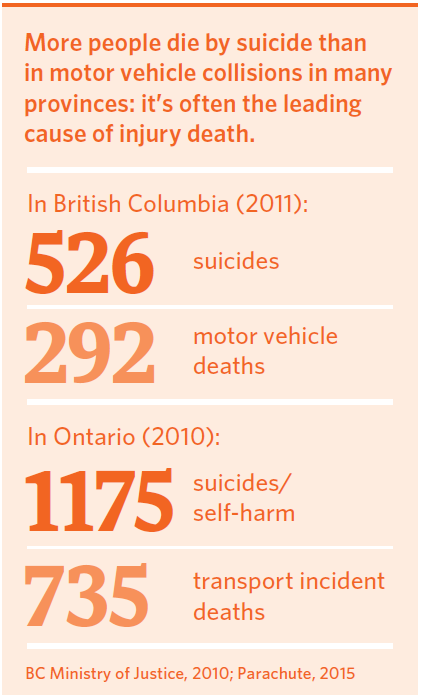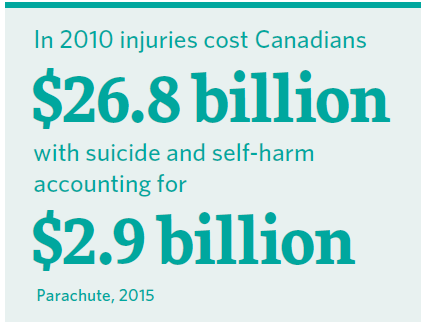If you are in distress, you can call or text 988 at any time. If it is an emergency, call 9-1-1 or go to your local emergency department.
- Fact sheets, Public Resources
Injury prevention and suicide
Injury prevention aims to reduce harm and increase safety for individuals, families and communities. There are two types of injury: intentional and unintentional. UNINTENTIONAL INJURIES INCLUDE THOSE CAUSED BY: INTENTIONAL INJURY INCLUDES: Anyone can be at risk of intentional injury. Here are some examples of high-risk groups: CHILDREN WHO SELF-HARM YOUTH WHO ENGAGE IN RISK-TAKING BEHAVIOUR YOUNG AND MIDDLE-AGED MEN TO PREVENT DEATH BY HANGING: TO PREVENT DEATH BY DRUG POISONING: TO PREVENT DEATH BY FIREARM: TO PREVENT DEATH BY CARBON MONOXIDE POISONING: TO PREVENT DEATH BY JUMPING: Skills-training programs, such as the Applied Suicide Intervention Skills Training (ASIST) workshop, aim to equip community members with the knowledge and skills to intervene with someone at risk of suicide. Constructing physical barriers on bridges is a highly effective injury and suicide prevention initiative. In the face of opposition, the City of Toronto erected bridge barriers on the Bloor Viaduct. The construction of this suicide barrier allowed the second deadliest suicide bridge in North America to become virtually free of suicides. Some theories suggest that bridge barriers do not deter suicide and that people will look for another means of suicide, however, research has shown that after the installation of the Bloor Viaduct barriers, the overall suicide rate in the city of Toronto decreased. Read More.This resource was published in 2017. The data may be out of date.
What is it?
• traffic collisions;
• falls;
• choking and suffocation; or
• fires and burns.
• self-harm;
• suicide; or
• domestic violence. Intentional injuries fundamentally differ from unintentional injuries, because intentional injuries are intended to cause harm, and are directly linked to mental health issues. Self-harming is a way for people with mental health concerns to ease their extreme psychological pain.
Intentional injuries fundamentally differ from unintentional injuries, because intentional injuries are intended to cause harm, and are directly linked to mental health issues. Self-harming is a way for people with mental health concerns to ease their extreme psychological pain.Who is at risk of intentional injury?
Children often harm themselves because of harms done to them. The intention of their self-harming behaviours may not be to die by suicide, but if not treated by a mental health professional, can escalate to suicidal behaviour (Centre for Suicide Prevention, 2014).
Youth who harm themselves are at greater risk for suicide and have underlying mental health issues or are trying to escape overwhelming and negative emotions (Klonsky, et al., 2014). Risk-taking behaviours, such as promiscuity, driving while intoxicated, or indulging in substance abuse, often lead to intentional and unintentional injury. Early intervention for youth effectively reduces suicide rates, however youth receive the least mental health assistance of all age groups (Standing Senate Committee on Social Affairs, Science and Technology, 2006). Getting vulnerable youth the medical and psychological attention they need should be a suicide prevention priority both nationally and provincially (Kutcher, 2008).
Generally, there is a reluctance by men to seek assistance for mental health issues. Men who live with depression and do not seek help may be at increased risk for suicide. This is especially true if there are co-occurring disorders such as substance abuse. Men will often mask their stress and cope with their depression through harmful behaviours and actions (Ogrodniczuk, 2011). Men die by suicide three times more often than women (Statistics Canada, 2014).Evidence-based strategies to prevent intentional injuries in Canada
1. Reduce Access to Lethal Means
• Redesign closet rods, window fittings and furniture to reduce ligature points.
• Regulate dosages by reducing pack size of potentially lethal pills.
• Dispose of unwanted medications properly.
• Make ongoing recommendations to governments regarding the classification and access of medications
by health professionals and the public where concerns arise.
• Use locked gun storage.
• Restrict access to firearms.
• Require all cars to have catalytic converters.
• Post phone number of the local distress centre on bridges and other high places.
• Construct bridge barriers (Institute for Health Economics, 2010).2. Educate
Case Study: Bridge Barriers
RESOURCES: A SELECTION OF CANADIAN INJURY AND SUICIDE PREVENTION STRATEGIES
- Fact sheets, Public Resources
Injury prevention and suicide
Injury prevention and suicide
- Children and Youth, Suicide Prevention
Injury prevention aims to reduce harm and increase safety for individuals, families and communities. There are two types of injury: intentional and unintentional. UNINTENTIONAL INJURIES INCLUDE THOSE CAUSED BY: INTENTIONAL INJURY INCLUDES: Anyone can be at risk of intentional injury. Here are some examples of high-risk groups: CHILDREN WHO SELF-HARM YOUTH WHO ENGAGE IN RISK-TAKING BEHAVIOUR YOUNG AND MIDDLE-AGED MEN TO PREVENT DEATH BY HANGING: TO PREVENT DEATH BY DRUG POISONING: TO PREVENT DEATH BY FIREARM: TO PREVENT DEATH BY CARBON MONOXIDE POISONING: TO PREVENT DEATH BY JUMPING: Skills-training programs, such as the Applied Suicide Intervention Skills Training (ASIST) workshop, aim to equip community members with the knowledge and skills to intervene with someone at risk of suicide. Constructing physical barriers on bridges is a highly effective injury and suicide prevention initiative. In the face of opposition, the City of Toronto erected bridge barriers on the Bloor Viaduct. The construction of this suicide barrier allowed the second deadliest suicide bridge in North America to become virtually free of suicides. Some theories suggest that bridge barriers do not deter suicide and that people will look for another means of suicide, however, research has shown that after the installation of the Bloor Viaduct barriers, the overall suicide rate in the city of Toronto decreased. Read More.
This resource was published in 2017. The data may be out of date.
What is it?
• traffic collisions;
• falls;
• choking and suffocation; or
• fires and burns.
• self-harm;
• suicide; or
• domestic violence. Intentional injuries fundamentally differ from unintentional injuries, because intentional injuries are intended to cause harm, and are directly linked to mental health issues. Self-harming is a way for people with mental health concerns to ease their extreme psychological pain.
Intentional injuries fundamentally differ from unintentional injuries, because intentional injuries are intended to cause harm, and are directly linked to mental health issues. Self-harming is a way for people with mental health concerns to ease their extreme psychological pain.Who is at risk of intentional injury?
Children often harm themselves because of harms done to them. The intention of their self-harming behaviours may not be to die by suicide, but if not treated by a mental health professional, can escalate to suicidal behaviour (Centre for Suicide Prevention, 2014).
Youth who harm themselves are at greater risk for suicide and have underlying mental health issues or are trying to escape overwhelming and negative emotions (Klonsky, et al., 2014). Risk-taking behaviours, such as promiscuity, driving while intoxicated, or indulging in substance abuse, often lead to intentional and unintentional injury. Early intervention for youth effectively reduces suicide rates, however youth receive the least mental health assistance of all age groups (Standing Senate Committee on Social Affairs, Science and Technology, 2006). Getting vulnerable youth the medical and psychological attention they need should be a suicide prevention priority both nationally and provincially (Kutcher, 2008).
Generally, there is a reluctance by men to seek assistance for mental health issues. Men who live with depression and do not seek help may be at increased risk for suicide. This is especially true if there are co-occurring disorders such as substance abuse. Men will often mask their stress and cope with their depression through harmful behaviours and actions (Ogrodniczuk, 2011). Men die by suicide three times more often than women (Statistics Canada, 2014).Evidence-based strategies to prevent intentional injuries in Canada
1. Reduce Access to Lethal Means
• Redesign closet rods, window fittings and furniture to reduce ligature points.
• Regulate dosages by reducing pack size of potentially lethal pills.
• Dispose of unwanted medications properly.
• Make ongoing recommendations to governments regarding the classification and access of medications
by health professionals and the public where concerns arise.
• Use locked gun storage.
• Restrict access to firearms.
• Require all cars to have catalytic converters.
• Post phone number of the local distress centre on bridges and other high places.
• Construct bridge barriers (Institute for Health Economics, 2010).2. Educate
Case Study: Bridge Barriers
RESOURCES: A SELECTION OF CANADIAN INJURY AND SUICIDE PREVENTION STRATEGIES
SHARE THIS PAGE
RELATED

Review our Assessment Framework for Mental Health Apps — a national framework containing key standards for safe, quality, and effective mental health apps in Canada.

To help expand the use of e-mental health services, we developed four online learning modules based on our Toolkit for E-Mental Health Implementation, in collaboration with the Centre for Addiction and Mental Health (CAMH).

Stepped Care 2.0© (SC2.0) is a transformative model for organizing and delivering evidence-informed mental health and substance use services.

